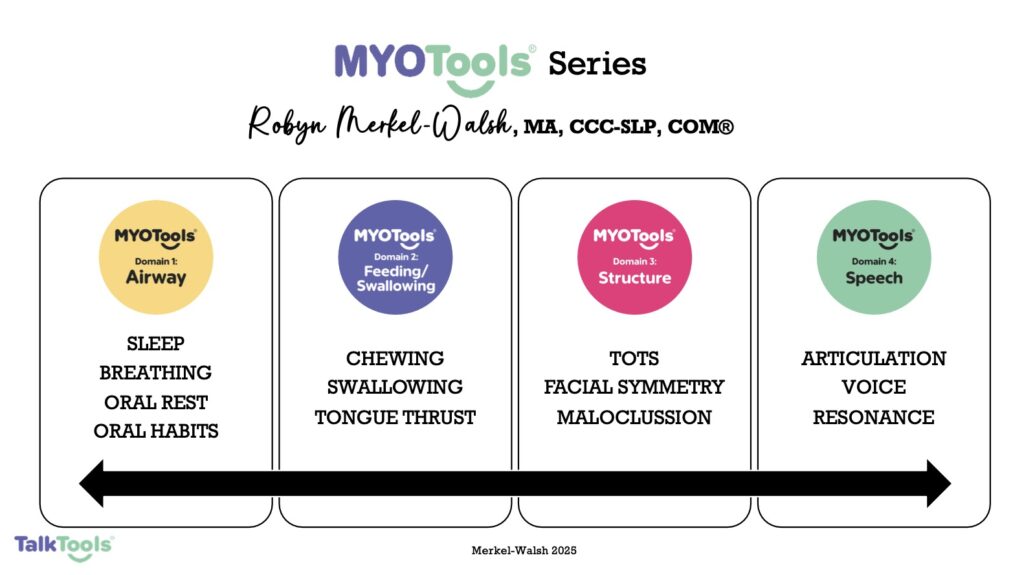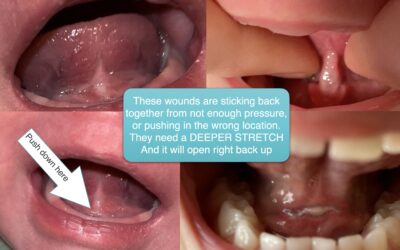by Robyn Merkel-Walsh, MA, CCC-SLP, COM®
Tongue tie, or ankyloglossia, is a condition that has gained increasing attention in speech-language pathology. While its implications for feeding and oral development are often discussed, its impact on speech can sometimes be overlooked. Drawing on insights from my own research, this newsletter delves into the speech-related symptoms of tongue tie and offers strategies for effective assessment and management.

Defining Tongue Tie
Tongue tie is characterized by a restrictive lingual frenulum, which limits the tongue’s range of motion. A tongue is tied when the frenulum is too short, too thick, too tight and/or in an atypical location (Merkel-Walsh & Overland, 2020). While this anatomical variation might seem minor, it can significantly influence speech production by hindering the tongue’s ability to move freely and achieve standardized placements needed for specific sounds.
Speech Symptoms Associated with Tongue Tie
Based on the research I have completed for Functional Assessment and Remediation of TOTs with Lori Overland (2018), in addition to multiple courses, lectures and papers, the following speech characteristics may be secondary to a tongue-tie:
- Articulation Challenges: Difficulty producing lingual sounds, particularly /s/, /z/, /r/, and /t, d, l, n, ʧ, ʤ, ʃ, ʓ/ due to limited tongue retraction, elevation or back- tongue side spread.
- Compensatory Patterns: Oral placements that are compensatory, such as interdental placement for /t, d, l, n, s, z/, resulting in reinforcement of tongue thrust patterns, lisping and speech distortions.
- Muffled Speech: A persistent lack of precision in speech that can mimic mild dysarthria (muscle-based weakness).
- Frustration or Avoidance: Children or adults with tongue tie may exhibit frustration during speech tasks, leading to avoidance of complex or lengthy verbal exchanges.
- Voice Problems: Changes to resonance and/or vocal quality may be impacted as noted in a study I co-authored (Summersgill et al., 2023) and in research for the ASHA Convention (Solomon & Merkel-Walsh, 2023).

The Importance of Comprehensive Assessment
In the text Functional Assessment and Remediation of TOTs (2018), Lori and I emphasized the need for a holistic approach to assessment, combining structural and functional examinations. Tools such as our functional assessment forms, the TOTs 5- Step Screening Tool and the Muscle-Based Articulation Test analyze speech-specific tasks, and therefore help professionals identify the common speech sound errors and compensatory strategies often associated with tongue tie.
Treatment Approaches
Effective treatment for speech symptoms involves a multidisciplinary team, as well as a combination of treatment modalities performed by a licensed speech-language pathologist who takes specialized training in ankyloglossia:
- Release and Rehabilitation: Collaboration with a qualified provider for frenotomy or frenuloplasty, in conjunction with pre- and post-neuromuscular re-education is key. Pre-and post-op intervention has been discussed by Smart et al, (2024), Baxter et al., (2020) and Merkel-Walsh & Overland (2024).
- Orofacial Myofunctional Therapy (OMT): OMT involves exercises to improve tongue posture, range of motion, strength and coordination. ASHA (n.d.) noted that speech will more likely improve when oral resting posture has improved with OMT.
- Oral Placement Therapy (OPT): OPT uses tools/tactile cues to practice speech- like movements that are immediately transitioned into speech as soon as the patient is ready (Bahr and Rosenfeld-Johnson, 2010). This method is helpful in neuromuscular re-education for tongue-tie.
- Speech Therapy: The SLP will help reduce compensatory patterns and work towards retraining normalized lingual articulation placements to improve speech intelligibility, such as tongue tip elevation for /t, d, l, n, s, z/.
Conclusions
Understanding the speech implications of tongue tie is crucial for professionals working in speech-language pathology. Research underscores the importance of treating the root cause rather than only addressing surface symptoms. An organic speech sound disorder that stems from a tongue-tie will most likely not respond quickly to traditional methods. My philosophy advocates for an individualized approach, tailored to the client’s specific needs, and a commitment to evidence-based practice.

References
American Speech-Language-Hearing Association. (n.d.). Orofacial Myofunctional Disorders. (Practice Portal). Retrieved 12/4/24 from www.asha.org/Practice- Portal/Clinical-Topics/Orofacial-Myofunctional-Disorders/
Bahr, D., & Rosenfeld-Johnson, S. (2010). Treatment of children with speech oral placement disorders (OPDs): A Paradigm Emerges. Communication Disorders Quarterly, 31(3), 131-138. https://doi.org/10.1177/1525740109350217
Baxter, R., Merkel-Walsh, R., Baxter, B. S., Lashley, A., & Rendell, N. R. (2020). Functional Improvements of Speech, Feeding, and Sleep After Lingual Frenectomy Tongue-Tie Release: A Prospective Cohort Study. Clinical pediatrics, 59(9-10), 885–892. https://doi.org/10.1177/0009922820928055
Merkel-Walsh, R. A., & Overland, L. L. (2024). Clinical perspectives on post-operative care for tethered oral tissues (TOTs). International Journal of Orofacial Myology and Myofunctional Therapy, 50(2), 1-13.
DOI: https://doi.org/10.52010/ijom.2024.50.2.2
Merkel-Walsh, R. A., & Overland, L. L. (2018). Functional assessment and remediation of tethered oral tissue(s). Charleston, SC: TalkTools®
Merkel-Walsh, R. A. & Overland, L.L. (2020). The functional assessment of tethered oral tissue. Live Virtual Presentation. Charleston, SC: TalkTools®
Smart, S., Grant, H., & Tseng, R. J. (2024). Beyond surgery: Pre- and post-operative care in children with ankyloglossia. International journal of Paediatric Dentistry, 10.1111/ipd.13235. Advance online publication. https://doi.org/10.1111/ipd.13235
Solomon, N. & Merkel-Walsh, R.A. (2023). What does the tongue have to do with muscle tension dysphonia? Live Presentation at the Annual Convention of the American Speech-Language-Hearing Association. Boston, MA.
Summersgill, I., et al. (2023). Muscle tension dysphonia in singers and professional speakers with ankyloglossia: Impact of treatment with lingual frenuloplasty and orofacial myofunctional therapy. International Journal of Orofacial Myology and Myofunctional Therapy, 49(1), 1-8. DOI: https://doi.org/10.52010/ijom.2023.49.1.1
About the Author:
Robyn Merkel-Walsh is a licensed speech-language pathologist, Board Certified Orofacial Myologist® and Vocologist with 30 years of experience in assessing and remediating orofacial myofunctional, feeding, swallowing and speech sound disorders. Robyn is a lecturer, author and product developer for TalkTools®, and is an ambassador and guest faculty member of The Breathe Institute. Robyn is the Board Chair of the Oral Motor Institute, serves on the ICAP Board of Directors and is a member of ASHA, IAOM, AAPMD, NJSHA, AAPPSPA and the NJEA. In her spare time she enjoys visiting Disney and New York City with her husband Chris and son Jaden, as well as spending time with her cats Vader and Obi.



